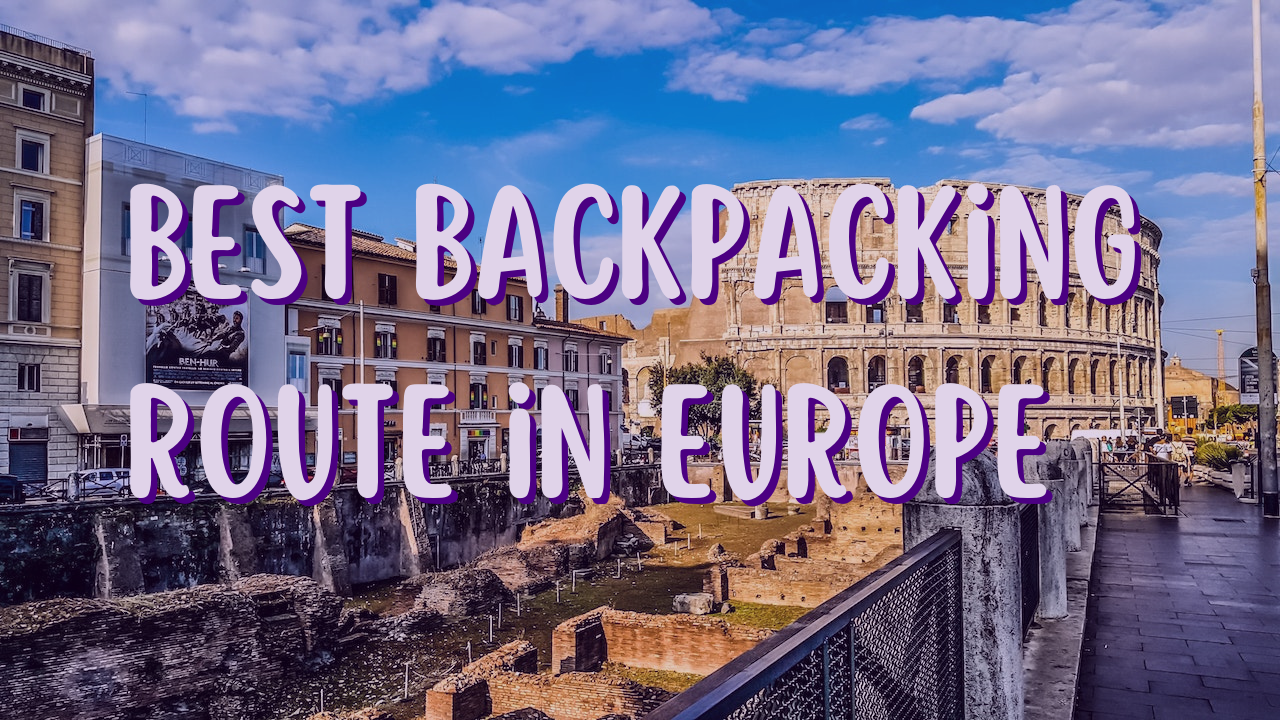After countless hours of research and planning, I’ve finally come up with the ultimate backpacking route that will satisfy both my wanderlust and my passion for all things tech-related.
Well, I’ve carefully crafted this journey to include not only Europe’s most iconic and picturesque sights but also its hidden technological gems and geeky havens. From cutting-edge tech hubs to quirky museums and gaming centers, this trip promises to blend history, culture, and modern innovation perfectly.

From budget-friendly accommodations to the best spots for indulging in local cuisine, from efficient travel hacks to must-visit tech hubs, this blog will be your ultimate guide as you navigate through the mesmerizing tapestry that is Europe.
I’ll be sharing my favorite tech gadgets and travel hacks, as well as tips on how to make the most of your time in each destination.
So whether you’re a fellow geek, a travel enthusiast, or simply someone looking for a unique European adventure, I invite you to join me on this incredible journey. Together, we’ll uncover the best backpacking route in Europe, one tech-savvy step at a time.
The best time to visit Europe for backpacking

The best time to visit Europe for backpacking is during the shoulder seasons, which are the spring months (March to May) and the fall months (late September to November). You can take advantage of lower prices on flights, trains, accommodations, tours, and food during these times. Additionally, there will be fewer tourists, allowing you to better connect with the locals and experience a more authentic glimpse into their lives.
Visiting Europe during the shoulder seasons offers a balance between pleasant weather and affordability, making it the ideal time for backpackers seeking a memorable experience without breaking the bank.
How to Travel Around Europe
Trains
Trains are an iconic way to travel around Europe, offering both comfort and stunning countryside views.
The extensive rail network connects major cities and smaller towns across the continent, making it a convenient option for backpackers.
Some advantages of train travel include:
- Scenic routes: Enjoy picturesque landscapes and charming towns as you travel through Europe by train.
- Comfort and convenience: Trains offer ample space for luggage, comfortable seating, and onboard amenities like dining cars and Wi-Fi.
- Eurail Pass: A popular option for backpackers, the Eurail Pass allows for unlimited train travel within participating European countries, providing flexibility and cost savings for longer trips.
Buses
Buses are an affordable alternative to trains, particularly for those traveling on a tight budget. Europe has a well-developed network of bus routes, with several companies offering long-distance and regional services. Some benefits of bus travel include:
- Low-cost fares: Buses often have cheaper fares than trains and planes, making them a budget-friendly choice.
- Extensive route coverage: Buses can reach more remote destinations not serviced by trains, allowing you to explore lesser-known locations.
- Online booking: Many bus companies offer easy online booking, allowing you to plan and reserve transportation in advance.
Budget Airlines
Budget airlines have revolutionized air travel in Europe, providing an affordable and efficient way to travel between major cities. With dozens of low-cost carriers operating throughout the continent, flying can be an attractive option for backpackers short on time.
- Competitive fares: Budget airlines often offer incredibly low fares, making it possible to travel between European cities at a fraction of the cost of traditional carriers.
- Time savings: Flying is the fastest way to travel long distances within Europe, allowing you to maximize your time at each destination.
- Additional fees: Be aware that budget airlines often charge extra for luggage, seat selection, and other services, so factor these costs into your overall budget.
Car Rentals
Renting a car provides the ultimate freedom to explore Europe at your own pace. While not the most budget-friendly option, car rentals offer unparalleled flexibility, allowing you to access off-the-beaten-path destinations and travel on your own schedule.
Factors to consider when renting a car include:
- Rental costs: Compare prices between rental companies, and consider factors like fuel efficiency, insurance, and additional fees.
- Driving regulations: Familiarize yourself with local driving laws and regulations, as they can vary between European countries.
- Parking and tolls: Be prepared for parking fees and road tolls, which can add up during your trip.
How much money do you need to backpack for Europe?
When planning a backpacking trip to Europe, it’s essential to consider your budget and daily expenses. The cost of your trip will vary greatly depending on the countries you visit, the length of your stay, the activities you engage in, your food choices, accommodation preferences, and more. To help you estimate your daily spending, here are some average costs for popular expenses while backpacking Europe:
Accommodation
- Hostels: €15-40 per night (shared dorm)
- Budget hotels: €40-100 per night (private room)
Food
- Inexpensive restaurant meal: €8-20
- Mid-range restaurant meal: €20-40
- Groceries (per day): €5-15
Transportation
- Local public transport: €1-3 per ride
- Long-distance bus or train: €15-50
- Budget flights: €30-150
Activities and entertainment
- Museum entrance fees: €5-20
- Guided tours: €20-50
- Nightlife: €5-20 for a drink at a bar or club
Miscellaneous daily expenses
- Coffee: €1-4
- Bottled water: €1-3
- Snacks: €1-5
I hope this will help you determine how much money you’ll need for backpacking in Europe.
Best Backpacking Route in Europe
Amsterdam, Netherlands

Known for its picturesque canals, historic architecture, and vibrant cultural scene, Amsterdam is a must-visit city on any Western European backpacking route. Be sure to visit the Anne Frank House, the Van Gogh Museum, and the bustling Albert Cuyp Market.
Paris, France

The City of Lights offers numerous iconic sights like the Eiffel Tower, Louvre Museum, and Notre-Dame Cathedral. Don’t forget to stroll along the Seine River, indulge in delicious pastries, and explore the charming Montmartre neighborhood.
Barcelona, Spain

This vibrant city boasts unique architecture by Antoni Gaudí, including the Sagrada Família and Park Güell. Be sure also to explore the bustling La Rambla street, relax on Barceloneta Beach, and visit the historic Gothic Quarter.
Southern Europe Backpacking Route
Rome, Italy

Discover ancient history at the Colosseum, Roman Forum, and Pantheon. Don’t forget to toss a coin in the Trevi Fountain, climb the Spanish Steps, and visit Vatican City, home to St. Peter’s Basilica and the Sistine Chapel.
Athens, Greece

The cradle of Western civilization offers iconic sites like the Acropolis, the Parthenon, and the Temple of Olympian Zeus. Explore the picturesque Plaka neighborhood, visit the National Archaeological Museum, and enjoy authentic Greek cuisine in local tavernas.
Dubrovnik, Croatia

This stunning coastal city, also known as the “Pearl of the Adriatic,” is famous for its well-preserved Old Town and city walls. Visit the Lovrijenac Fortress, take a cable car to Mount Srđ, and explore the nearby island of Lokrum.
Eastern Europe Backpacking Route
Prague, Czech Republic

The enchanting Czech capital features historic sites like Prague Castle, Charles Bridge, and Old Town Square. Also, visit the unique John Lennon Wall, take a stroll through the Jewish Quarter, and enjoy local brews in traditional Czech pubs.
Budapest, Hungary

This city on the Danube River is known for its thermal baths, like the Gellért and Széchenyi Baths. Don’t miss the historic Buda Castle, the iconic Parliament building, and the Great Market Hall for traditional Hungarian dishes and souvenirs.
Kraków, Poland

This historic city offers a wealth of attractions, such as the Wawel Castle, St. Mary’s Basilica, and the medieval Main Market Square. Additionally, pay a visit to the nearby Auschwitz-Birkenau concentration camp memorial and the Wieliczka Salt Mine.
The Takeaway
I hope this guide helps you plan an incredible European backpacking adventure that suits your interests, budget, and travel preferences.
By considering the best time to visit, transportation options, daily expenses, and carefully chosen destinations, you can create a memorable journey that will provide lasting memories and enrich your understanding of Europe’s diverse history, culture, and natural beauty.

Meet Kein, a young solo adventurer traversing the globe, seeking out the most thrilling experiences. Through this blog, he documents his daring journeys, offering a blend of adventure tales and invaluable tips for like-minded explorers.








1 thought on “Best Backpacking Route in Europe”